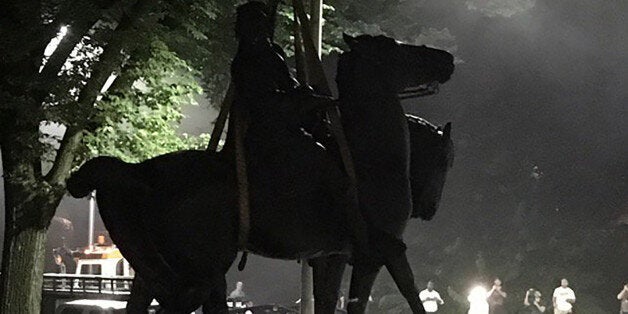
Not only did the white supremacist violence in Charlottesville last week begin, nominally, over a dispute about a statue in a public park, but the national debate about racism, history and political identity that it provoked has now morphed into one about the future of such statues. In recent years, public monuments have often become sites for political struggle. The reasons for this may seem self-evident. Statues are a way of memorialising figures and events from our history, and as such, are part of the way the narrative of that history is constructed and remembered. But as recent research shows, their meaning is only partially about them as objects of historical art. Equally important for this meaning is the discourse they generate - the ideas and opinions that people project onto them - which is fluid, open to different interpretations, and can thus become a potent political weapon. And it's for this reason that the arguments over the Confederate statues are as much about modern-day identity politics as they are about how to deal with the troubled legacy of the past - and why Donald Trump's seemingly-provocative position on them still receives so much support.
A public monument derives its meaning from a number of different factors including, particularly, its provenance and placement. Importantly, it's not just the history that's depicted in the subject of the statue, but also the history of its creation which points to the intended symbolic purpose behind it. Of the several hundred Confederate monuments around the US, for example, the majority were put up not in the immediate aftermath of the Civil War itself, but around the years 1905 to 1910. This was the period following the enacting of Jim Crow laws, and a time when the Ku Klux Klan was becoming resurgent in the American south. In other words, the statues were a symbolic part of a general racist ideology spreading across the culture at that point in history.
Then there's the geographical space in which statues are positioned. A potent example of this comes from South Korea and the statues of 'comfort women' - those women forcibly made to work as sex slaves for the Japanese army during World War Two - which have been erected as both memorials and political statements in different locations in the country over the last year. In December of 2016 one such statue was put up by a civil group directly in front of the Japanese consulate in the city of Busan. The confrontational positioning of this was purposefully provocative, and ultimately led to strained diplomatic relations between Japan and South Korea, exacerbating the long-running political rift between the two countries.
A different symbolic purpose underlies similar statues which appeared on buses around Seoul earlier this month. The 14th August is commemorated as International Comfort Women Day in South Korea, and this year several statues of women, barefoot and wearing traditional Korean dress, were placed on bus seats travelling across the capital as a way of keeping the memory of this group alive by interweaving it into the mundane routines of everyday life.
Context, therefore - both historical and geographical - is key to the interpretation of the symbolism of statues. But this interpretation is also shaped in a very explicit manner beyond the statues themselves, in the way they're represented in the media - and particularly social media. A common rhetorical tactic here - be it in alt-right memes or tweets from the president - is false equivalency. There are memes, for example, showing images of the Taliban desecrating ancient monuments with the caption 'The nationwide eradication of Confederate monuments reminds me of something'. Or others asking
If they're gonna remove Confederate Civil War statues because of those ties to slavery do we next bring down the Statue of Liberty because Obamacare took away individual freedoms of choice in healthcare?
The Statue of Liberty has, in fact, become a front-line symbol of contested meaning in recent politics. Earlier in the month an editor for Breitbart News complained that the latest cover of Vogue, which depicts the actress Jennifer Lawrence with the Statue of Liberty in the background, was using the imagery of the statue as part of a pro-immigration agenda. 'If you want the Statue of Liberty to be a non-partisan symbol of America', he tweeted, 'don't make her central to your case against immigration reform'. This came soon after White House adviser Stephen Miller's argument with a reporter about the meaning of the poem at the base of the Statue of Liberty, in which he likewise took issue with the idea that it should be viewed as a symbol celebrating the immigrant roots of the country.
There are over 700 Confederate monuments still scattered across the US. And although public sentiment following the events in Charlottesville may appear for the most part to condemn the history they represent, as the journalists Kathryn Casteel and Anna Maria Barry-Jester write in FiveThirtyEight, the movement to dismantle them could in fact end up 'providing a platform for white nationalist protesters'.
Certainly there's an element of this in the way that Donald Trump is trying to recast the struggle over their future as being about the history and heritage of the country, tweeting that it's 'Sad to see the history and culture of our great country being ripped apart' with the removal of the statues. And it's a narrative that seemingly plays well to a large section of the population - a poll reported on in New York Times showed that 86 per cent of Republicans were in favour of keeping the monuments for reason related to the heritage of the country.
In this respect, then, the meaning of the statues is far from clear-cut, and amplifying aspects of the controversy may in fact be a way for Trump to bolster support for his position, allowing him to fan anxiety over cultural change. As the White House chief strategist Steve Bannon boasted to reporter Robert Kuttner in the aftermath of the president's equivocal statements about the events in Charlottesville, 'the longer [the Democrats] talk about identity politics, I got 'em. I want them to talk about racism every day. If the left is focused on race and identity, and we go with economic nationalism, we can crush [them]'.
